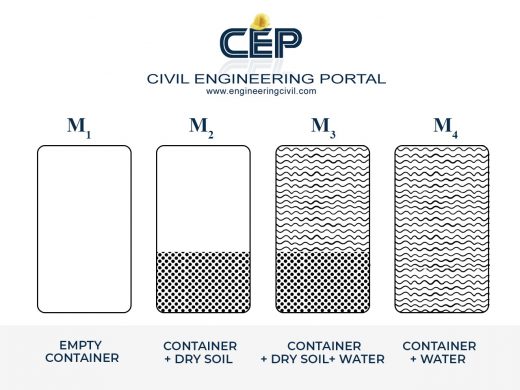Keywords: Pycnometer, specific gravity, density, density bottle, glass jar, dry soil.
The specific gravity of solid particles can be determined in the laboratory using the following methods:
1. Density bottle method
2. Pycnometer method
3. Measuring flask method
4. Gas jar method
5. Shrinkage limit method
1. Density bottle method
The specific gravity of solid particles can be determined in a laboratory using a density bottle fitted with a stopper having a hole. The density bottle of 50 ml capacity is generally used [IS: 2720 Part 2 1980].
The density bottle is cleaned and dried at a temperature of 105 to 110 degree celsius and cooled. The mass of the bottle, including that of stopper is taken. About 5-10g of oven dried sample soil is taken in the bottle and weighed. If the sample contains particle of larger size, it shall be ground to pass a 2-mm sieve before the test.
Distilled water is then added to cover the sample. The soil is allowed to soak water for about 2 hours. More water is added until the bottle is half full. Air entrapped in the soil is expelled by applying a vacuum pressure of about 55cm of mercury for about one hour in a vacuum desiccator. Alternatively, the entrapped air can be removed by gentle heating. More water is added to the bottle to make it full. The stopper is inserted in the bottle and its mass is taken. The temperature is also recorded. The bottle is emptied, washed and then refilled with distilled water,. The bottle must be filled to the same mark as in the previous case. The mass of the bottle filled with water is taken. The temperature should be same as before.
Let M1= mass of empty bottle
M2 = mass of bottle and dry soil
M3= mass of bottle, soil and water
M4= mass of bottle filled with water
If mass of solids Ms is subtracted from M3 and replaced by the mass of water equal to the volume of solid, the mass M4 is obtained.
Specific Gravity G= Ms/(Ms+M4-M3)
Kerosene is a better wetting agent than water and is sometimes used in place of water. If Gk is the specific gravity of kerosene at the test temperature, the equation will be
G= [(M2-M1) Gk] / [(M2-M1)-(M3-M4)]
Sometimes, other liquids, such as paraffin, alcohol and benzene are also used.Density bottle method is suitable for fine grained soils; with more than 90% passing 2mm IS sieve. However the method can also be used for medium and coarse grained soils if they are pulverized such that the particles can pass through 2mm IS sieve.
2. Pycnometer method
This method is similar to the density bottle method which is discussed as above. As the capacity of the pycnometer is larger, about 200-300g of oven dry soil is required for the test. The method can be used for all types of soils, but is more suitable for medium grained soils; with more than 90% passing a 20 mm IS sieve and for coarse grained soils with more than 90% passing a 40 mm IS sieve.
The specific gravity of solids, G is determined using following equation:
G= (M2-M1)/[(M2-M1)-(M3-M4)]
Where M1= mass of empty pycnometer
M2= mass of pycnometer and dry soil
M3= mass of pycnometer, soil, and water
M4= mass of pycnometer filled with water only
3. Measuring flask method
Measuring flask is of 250 ml (or 500 ml) capacity, with a graduation mark at that level. It is fitted with an adaptor for connecting it to a vacuum line for removing entrapped air. The method is similar to the density bottle method. About 80-100g of oven dry soil is required in this case. The method is suitable for fine grained and medium grained soils.
4. Glass Jar method
In this method a glass jar of about 1 liter capacity is used. The jar is fitted with a rubber bung. The glass jar serves as a pycnometer. This method is also similar to the pycnometer method as discussed above.
5. Shrinkage limit method
Click here to view Shrinkage limit method
If you have a query, you can ask a question here.



